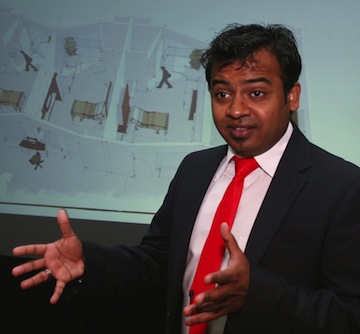Houston-based WHR Architects has named Lia Rodi, AIA, LEED AP, as the new curator of the firm’s Tradewell Fellowship Program, now in its 15th year. A past Tradewell Fellow, Rodi’s first official duty was the announcement of the 2012 Fellow Akshay Sangolli.
“It’s an honor to assume responsibility for the Tradewell program,” said Rodi. “Fourteen years ago, my own year as a Tradewell Fellow under the guidance of Kirk Hamilton was the ideal preparation for my new role. My experience and work with other Tradewells over the years has provided a model that will help to be of the best possible service to the Fellowship as a leader and mentor.”
Although internships are a tradition in the architectural profession, there are still few fellowships that offer recent graduates a focused opportunity to gain experience working closely with senior firm leaders and significant interaction with clients. This year’s Fellow, Akshay Sangolli, pursued the Tradewell in recognition of its exceptional nature. “It is a unique opportunity that puts you at an entirely different level at the outset of your career,” said Sangolli. “The Tradewell Fellowship offers [a] perfect combination of professional guidance, academic realization, and hands-on learning.”
The year-long Tradewell Fellowship was established by David Watkins, FAIA, president and chairman of WHR Architects, along with Kirk Hamilton, FAIA, FACHA, EDAC, now a professor at Texas A&M University and associate director for the Center for Health Systems and Design, in honor of the late Gary Tradewell, a former vice president and medical planner at WHR. The fellowship focuses on building careers of aspiring healthcare architects. Each year the Tradewell Fellow is involved with clients in early master planning and design, with a particular focus on healing environments and collaborative design methods as part of their employment at WHR. In addition to working directly with senior medical planners on design projects, Fellows receive career guidance from leaders at WHR and a network of past Tradewell Fellows.
In addition to project assignments, the Fellow also receives a scholarship to attend a healthcare architecture conference, and the opportunity to attend in-house educational presentations. Other educational opportunities include: assisting with teaching a graduate-level course on health facility planning, design, and construction; participating in evidence-based design activities; and assisting members of the firm in authoring speeches, articles, or books.
Fellows are selected by the group of past Tradewells at WHR, based on the strength of their design portfolios, letters of recommendation, and essays describing their accomplishments and career goals.
Sangolli, who began his fellowship in June, summarized his goals: “In the long term, I want explore how architecture can enhance human health, healing and well-being. I hope to participate in improving the quality of the built environment and its implications on human life around the world, especially in much-neglected developing nations.”
Related Stories
| Jan 19, 2011
Architecture Billings Index jumped more than 2 points in December
On the heels of its highest mark since 2007, the Architecture Billings Index jumped more than two points in December. The American Institute of Architects reported the December ABI score was 54.2, up from a reading of 52.0 the previous month.
| Jan 19, 2011
Large-Scale Concrete Reconstruction Solid Thinking
Driven by both current economic conditions and sustainable building trends, Building Teams are looking more and more to retrofits and reconstruction as the most viable alternative to new construction. In that context, large-scale concrete restoration projects are playing an important role within this growing specialty.
| Jan 10, 2011
Architect Jean Nouvel designs an island near Paris
Abandoned by carmaker Renault almost 20 years ago, Seguin Island in Boulogne-Billancourt, France, is being renewed by architect Jean Nouvel. Plans for the 300,000-square-meter project includes a mix of culture, commerce, urban parks, and gardens, which officials hope will attract both Parisians and tourists.
| Jan 10, 2011
Michael J. Alter, president of The Alter Group: ‘There’s a significant pent-up demand for projects’
Michael J. Alter, president of The Alter Group, a national corporate real estate development firm headquartered in Skokie, Ill., on the growth of urban centers, project financing, and what clients are saying about sustainability.
| Jan 7, 2011
BIM on Target
By using BIM for the design of its new San Clemente, Calif., store, big-box retailer Target has been able to model the entire structural steel package, including joists, in 3D, chopping the timeline for shop drawings from as much as 10 weeks down to an ‘unheard of’ three-and-a-half weeks.
| Jan 7, 2011
How Building Teams Choose Roofing Systems
A roofing survey emailed to a representative sample of BD+C’s subscriber list revealed such key findings as: Respondents named metal (56%) and EPDM (50%) as the roofing systems they (or their firms) employed most in projects. Also, new construction and retrofits were fairly evenly split among respondents’ roofing-related projects over the last couple of years.
| Jan 7, 2011
Total construction to rise 5.1% in 2011
Total U.S. construction spending will increase 5.1% in 2011. The gain from the end of 2010 to the end of 2011 will be 10%. The biggest annual gain in 2011 will be 10% for new residential construction, far above the 2-3% gains in all other construction sectors.
| Jan 7, 2011
Mixed-Use on Steroids
Mixed-use development has been one of the few bright spots in real estate in the last few years. Successful mixed-use projects are almost always located in dense urban or suburban areas, usually close to public transportation. It’s a sign of the times that the residential component tends to be rental rather than for-sale.














